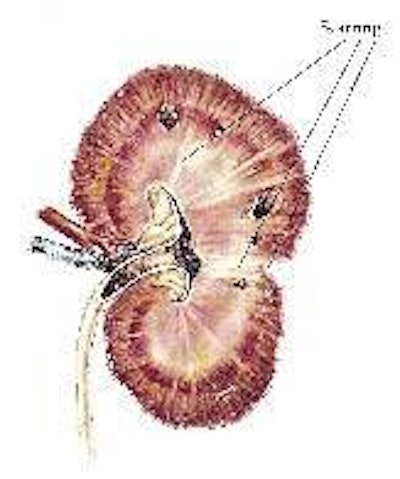
Chronic renal failure (CRF) is a common clinical condition in cats. Its prevalence is 30% in animals more than 15 years old. Clearly, preventing kidney disease could have a major impact on feline health. Although there is no direct experimental evidence, it is reasonable to suggest that a low dietary phosphorus concentration contributes to the prevention of renal disease.
Claims vs. reality
Various complete diets for senior cats claim to help prevent kidney disease. Out of 12 such diets for senior cats, five diets explicitly linked a low phosphorus content with the claim. Given an ideal dietary phosphorus concentration of 0.2-0.3 g/MJ, the label claim for three out of the five diets can be considered misleading.
The progression of CRF can be diminished and thus survival of the patient extended, but the condition cannot be healed. There now is strong evidence that appropriate dietary management, especially a low phosphorus intake, will enhance survival of cats with CRF. Consequently, some researchers theorize that restricting phosphorus intake will reduce the risk of the disease developing.
Evidence of efficacy
Phosphorus restriction diminishes the severity of histologically determined kidney mineralization and fibrosis in cats with induced renal failure, indicating that loss of kidney function was retarded (see Table 1, p. 36). In rat models of renal failure, similar results have been observed. There is a consensus that phosphorus restriction counteracts the renal secondary hyperparathyroidism and subsequent kidney mineralization. Lowering of nephrocalcinosis diminishes the loss of nephrons commonly seen in CRF and thereby retards the progression of the disease to end stage. Thus, a low phosphorus concentration is the mainstay in the dietetic food for cats with CRF.
Theoretical considerations and experimental research have led to further dietary modifications that may be benefit patients with CRF. Apart from phosphorus restriction, the characteristics of a dietetic food for feline kidney patients are protein restriction, low sodium content, high potassium content, a positive base excess, application of the nitrogen trap and a high level of eicosapentaenoic acid. Also, it is important to ensure the restriction of essential nutrients does not cause a deficiency.
A prospective study with cats has demonstrated that a dietetic food decreased the decline of kidney function and increased survival time (Elliot et al., 2000). In a retrospective study, an increase in survival time was found when feline patients were fed a dietetic food instead of a normal diet (Plantinga et al., 2005). On average, the survival time from CRF diagnosis is eight months without dietary treatment, but 20 months when an appropriate kidney diet is fed.
Scrutinizing dietary phosphorus levels
A decrease in phosphorus intake lowers kidney calcification in healthy cats (Pastoor et al., 1995a). Nephrocalcinosis is considered a crucial factor in initiating the loss of nephrons.
Phosphorus in diets is present in the form of various organic and inorganic phosphates. The minimum total phosphorus requirement of adult cats fed a purified diet is 0.1-0.2 g/MJ (Pastoor et al., 1995b). Dry diets may contain 25% of total phosphorus in unavailable phytate form so the minimum range for these diets is 0.13-0.27 g/MJ (0.20-0.41%). A proper kidney diet for adult patients should contain a phosphorus concentration in the minimum range, but not a lower concentration so as to prevent phosphorus deficiency.
Evaluation of diets for senior cats
It may not be required that a preventive diet be as harshly restricted in phosphorus as is a dietetic food for CRF patients. Thus, it could be suggested that a diet for senior cats should contain 0.2-0.3 g phosphorus/MJ. For comparison, the phosphorus requirement of kittens is 0.5 g/MJ. Obviously, adult cats at maintenance have a lower phosphorus requirement than do young growing cats.
Plantinga and Beynen (2003) chemically analyzed and qualified 15 commercially available, complete diets for senior cats. Manufacturers of 12 diets claimed the diets would contribute to the prevention kidney disease. Labels for five of the 12 diets explicitly linked their alleged low phosphorus content with the claim.
Table 2 documents the analyzed phosphorus contents of the five diets and the label values. Diets 1, 2 and 5 are very high in phosphorus when compared to the ideal range of 0.27-0.4 g/MJ for dry diets 1 and 5, and an ideal range of 0.2-0.3 g/MJ for canned diet 2. The analyzed phosphorus contents of diets 1 and 5 are considerably higher than the values in the guaranteed analyzed panel on the package. The analyzed value of diet 2 was extremely high. The claim that the diets 1, 2 and 5 are low in phosphorus can be considered misleading. Diets 3 and 4 had appropriately low phosphorus contents, the label values closely matching the analyzed values.
Misleading labels?
There is circumstantial evidence to conclude that a low intake of phosphorus may contribute to prevention of renal disease of cats. The corresponding claim frequently associated with diets for senior cats can thus be appreciated. The phosphorus content of such diets should be in the range of 0.27-0.4 g/MJ for dry diets and 0.2-0.3 g/MJ for canned diets. However, there are manufacturers claiming a low phosphorus content for diets for senior cats, and their claims can be considered misleading.


















